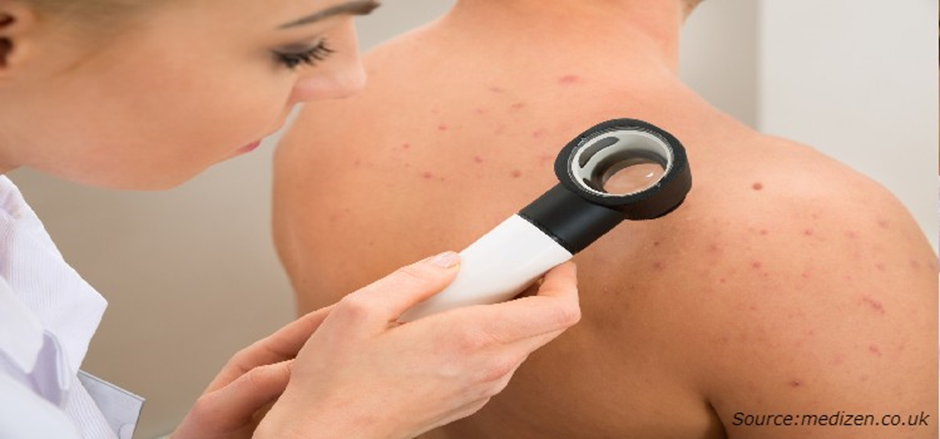
Acne Medication Market by Therapeutic Class (Retinoids, Antibiotics, Benzoyl Peroxide, Salicylic Acid, and Others), Formulation (Topical Medications and Oral Medications), Type (Prescription Medicines and Over-The-Counter Medicines), Acne Type (Non-Inflammatory Acne and Inflammatory Acne), and Distribution Channel (Retail Stores, E-Commerce, and Pharmacies & Drug Stores) – Global Opportunity Analysis and Industry Forecast, 2023-2030
Industry: Retail and Consumer | Publish Date: 12-Jan-2023 | No of Pages: 407 | No. of Tables: 347 | No. of Figures: 263 | Format: PDF | Report Code : N/A
Market Definition
The global Acne Medication Market was valued at USD 10.08 billion in 2021 and is predicted to reach USD 14.26 billion by 2030, with a CAGR of 3.02% from 2022 to 2030. Acne is a type of skin condition in which the hair follicles become plugged with dead skin cells and oil.
Two varieties of acne are non-inflammatory and inflammatory, with the inflammatory taking longer to cure and potentially leaving permanent consequences on the skin. It develops when the openings of hair follicles become clogged and blocked with oil or dead skin cells.
This condition further causes blackheads, whiteheads, or pimples. Acne is most common among teenagers and generally affects skin with a relatively high number of sweat glands such as the back, upper part of the chest, and face. Drugs involved in the treatment of acne are referred to as acne medication. Such type of medication comprises several prescription and over-the-counter medicines such as retinoids, benzoyl peroxide, antibiotics, isotretinoin, salicylic acid, and oral contraceptives.
In addition, acne medication includes medicated creams, gels, and ointments that are applied directly to infected parts of the body to reduce oil production and swelling. In the case of moderate to severe acne, oral medication is preferred for treatment.
Adoption of Acne Medication, Owing to Unhealthy Food Habits and Sedentary Lifestyles
Acne is mainly associated with a diet rich in fats, calories, and refined carbohydrates. It includes food items, such as burgers, hot dogs, potato fries, sodas, nuggets, and milkshakes, which support and may lead to an increased risk of acne.
According to the National Library of Medicine, around 5,000 Chinese young adults and teenagers found that high-fat diets were linked with a 43% higher risk of developing acne. Diets comprising large amounts of omega-6 fatty acids have been associated with increased levels of inflammation and acne.
Furthermore, inactivity or sedentary lifestyles negatively affect the skin with extra fat leading to an increased body mass index, which contributes to a number of health issues. This further leads to issues associated with the hormones, affecting the skin. Thus, unhealthy food habits and the rise in sedentary lifestyles fuel the acne treatment market share.
Occurrence of Acne Vulgaris Condition in Teenagers and Adults
Acne vulgaris is one of the most common skin conditions affecting adolescents & adults across the globe. Teenagers are most likely to get acne, owing to their diet, genetics, and hormones during puberty. For instance, acne vulgaris is estimated to affect over 50 million people in the U.S. while about 85% of teenagers are affected by acne; however, it can occur in any age group with many cases persisting into adulthood.
Furthermore, according to the U.S. National Institutes of Health, around 80% of people aged between 11 to 30 experience acne at some point in their lives. On the contrary, adults, particularly women are more likely to develop acne from hormonal fluctuations during menstruation as well as pregnancy. Hence, the occurrence of acne vulgaris condition in teenagers & adults propels the acne medication market growth.
Side Effects of Acne Medications and Substitute Acne Treatment Options
Various acne medications have different side effects that vary depending on the consumption method user chooses, as well as the strength of the medication. For instance, topical acne drugs have the most common side effects of skin irritation and dryness. On the other hand, antibiotics may result in an upset stomach or make the user lightheaded and dizzy.
In addition, side effects of oral contraceptives include high blood pressure and increased risk of blood clots. Moreover, this medication may have the side effect of suicidal thoughts and increased risk of depression, along with the effect on cholesterol levels and liver function. Such side effects of acne medications hamper the growth of the acne drug industry.
The Emergence of Effective Acne Medications with Minor Side Effects
Leading market players are significantly making efforts to introduce effective acne medications with minor side effects. For instance, in February 2020, Sun Pharmaceutical Industries Ltd., an Indian multinational pharmaceutical company announced that one of its subsidiaries has launched ABSORICA LD (isotretinoin) capsules in the U.S. for the management of severe recalcitrant nodular acne in patients aged 12 years and older. Development as well as the proliferation of such acne medication products are anticipated to create lucrative growth opportunities for the acne treatment market.
North America Holds a Major Share of the Acne Drug Market
North America leads in the market, owing to factors such as unhealthy lifestyles including a diet of the urban population that leads to the prevalence of acne in this region. According to the American Academy of Dermatology (AAD), around 50 million people suffered from acne in the U.S. in 2021.
Moreover, the presence of major key players such as Bausch Health Companies Inc., Mylan N.V., Pfizer Inc, and Johnson & Johnson further boosts the acne medication market growth in this region. For instance, in April 2020, Procter & Gamble-owned, Olay launched a new range of retinol products to target busy millennials. It consists of three products including serum, night cream, and eye cream, all of these products aim to treat acne-related problems. In addition, the United States Food and Drug Administration (FDA) is approving a number of acne treatment medicines with a number of ingredients.
For instance, in July 2021, Sol-Gel Technologies, a clinical-stage pharmaceutical company created a single-application acne treatment cream, combining two generally used ingredients: benzoyl peroxide and tretinoin. The FDA has approved tretinoin and benzoyl peroxide cream for treating acne vulgaris in individuals 9 years and older.
Europe is Expected to Show a Steady Rise in the Acne Medication Market
The rise in awareness and easy accessibility of acne medication by the common public, owing to the well-established healthcare infrastructure in this region propels the acne medication market growth. Moreover, advancements in acne medication and rigorous R&D activities by companies in Europe such as Almirall SA, Galderma SA, and GlaxoSmithKline Plc (GSK) further boost the market growth in this region. For instance, in January 2021, GlaxoSmithKline entered into a research collaboration with Eligo Bioscience. Under this strategic collaboration, GlaxoSmithKline aimed for advanced research and development of microbiome gene therapy of Eligo Bioscience called Eligobiotics for acne treatment.
Competitive Landscape
The acne medication industry comprises various market players such as Almirall SA., Bausch Health Companies Inc., Galderma S.A, Mayne Pharma Group Limited, GlaxoSmithKline Plc (GSK), Mylan N.V., Pfizer Inc., Johnson & Johnson, Sun Pharmaceutical Industries Limited, and Teva Pharmaceutical Industries Ltd. These market players have completed acquisitions and launched numerous products across various regions to maintain their dominance in the acne medication market.
For instance, in January 2022, Galderma S.A announced the acquisition of ALASTIN Skincare Inc. This acquisition allowed Galderma to expand its product portfolio and global market presence. Moreover, in June 2021, Almirall SA. received approval from the US Food and Drug Administration (FDA) to produce an oral antibiotic called Seysara. This approval allowed Almirall to sell Seysara in the US market to be used for treating moderate to severe acne.
Acne Medication Market Key Segments
By Therapeutic Class
-
Retinoids
-
Topical & Combination Retinoids
-
Oral Retinoids (Isotretinoin)
-
-
Antibiotics
-
Topical & Combination Antibiotics
-
Oral Antibiotics
-
-
Benzoyl Peroxide
-
Salicylic Acid
-
Others
By Formulation
-
Topical Medications
-
Oral Medications
By Type
-
Prescription Medicines
-
Over-The-Counter Medicines
By Acne Type
-
Non-Inflammatory Acne
-
Inflammatory Acne
By Distribution Channel
-
Retail Stores
-
E-Commerce
-
Pharmacies & Drug Stores
By Region
-
North America
-
U.S.
-
Canada
-
Mexico
-
-
Europe
-
Germany
-
France
-
Italy
-
Spain
-
United Kingdom
-
Russia
-
Sweden
-
Rest of Europe
-
-
Asia-Pacific
-
Australia
-
China
-
India
-
Japan
-
South Korea
-
Indonesia
-
Singapore
-
Rest of Asia-Pacific
-
-
RoW
-
UAE
-
Brazil
-
South Africa
-
Israel
-
KSA (Kingdom of Saudi Arabia)
-
Turkey
-
Others
-
Report Scope and Segmentation
|
Parameters |
Details |
|
Market Size in 2022 |
USD 10.08 Billion |
|
Revenue Forecast in 2030 |
USD 14.26 Billion |
|
Growth Rate |
CAGR of 3.1% from 2023 to 2030 |
|
Analysis Period |
2022–2030 |
|
Base Year Considered |
2021 |
|
Forecast Period |
2023–2030 |
|
Market Size Estimation |
Billion (USD) |
|
Growth Factors |
Adoption of acne medication, owing to unhealthy food habits sedentary lifestyles Occurrence of acne vulgaris condition in teenagers & adults |
|
Countries Covered |
26 |
|
Companies Profiled |
10 |
|
Market Share |
Available for 10 companies |
|
Customization Scope |
Free customization (equivalent up to 80 analysts working hours) after purchase. Addition or alteration to country, regional & segment scope. |
|
Pricing and Purchase Options |
Avail customized purchase options to meet your exact research needs. |
KEY PLAYERS
-
Almirall SA
-
Bausch Health Companies Inc
-
Galderma SA
-
Mayne Pharma Group Limited
-
GlaxoSmithKline Plc (GSK)
-
Mylan N.V.
-
Pfizer Inc.
-
Johnson & Johnson
-
Sun Pharmaceutical Industries Limited
-
Teva Pharmaceutical Industries Ltd.




 Speak to Our Analyst
Speak to Our Analyst


































